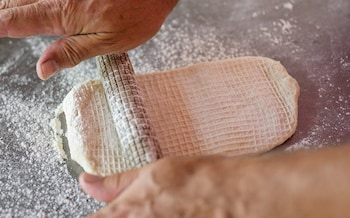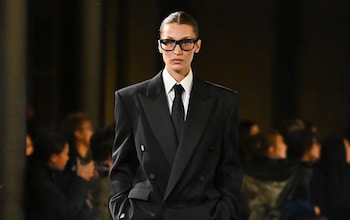I’ve been a jewellery editor for over 25 years and here’s what I’ve noticed. A strange confession perhaps for someone who has spent a career chasing the next big thing, but sometimes the oldest pieces appear the most modern. Take, for example, the vintage bronze coin necklace from the 1970s that Taylor Swift wore recently which looked so cool and contemporary whilst harking back to Ancient Rome.
That’s the reason why I’m seduced by the geometric outlines of the 1920s “Machine Age”, a period when jewellery took inspiration from the thrilling world of mechanisation. My favourite ring is a French creation from this era, whose design mimics cogs and wheels and camshafts – essentially the new engineering parts for cars and aircraft produced at the time. I’d never give it the lacklustre description of timeless, although it is around 100 years old – it’s too thrilling for that. Every time I wear it, I sense a frisson of speed and excitement.
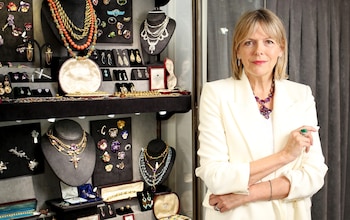
The other rings I often wear have an armorial protective quality about them. A shield ring by Diane Kordas rises up my second finger and an evil eye by Bee Goddess twinkles on my pinkie. I wore them both throughout lockdown and now I feel wrong and a bit naked if I leave home without them.
The trick is to buy pieces you never tire of, and you can only do that by trying it on for size and getting the measure of how you feel wearing it. Admittedly that was made easy for me – albeit financially hazardous. When I worked at Vogue, so many jewellery designers came to Vogue House for “desk side” appointments and I was forever trying pieces on, then dashing along the corridor to look in the loo mirror for a quick look. That’s why I couldn’t allow jeweller Susan Foster to take away a pair of white agate drop earrings – they had to come home with me.
Earrings and rings are my particular temptation. It’s important to know which pieces suit your body because the point of jewellery is to flatter your best features. I’d never buy jewellery for a particular outfit or occasion because it should work with your whole wardrobe. Plus, bear in mind that it has to fit into your working life. When I’m recording my If Jewels Could Talk podcast or if I‘m writing an article and typing, I find cuffs and bracelets cumbersome and the clanking sound annoying.
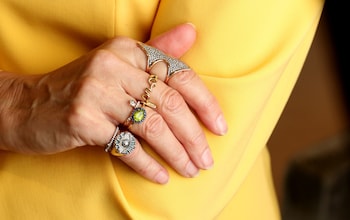
I have collected a few crosses over the years. They were originally worn as an amuletic pendant in Cyprus between 4000 and 2500 BC, and the simplicity of its streamlined form remains fresh today. I was schooled at a convent so maybe I’m drawn to keeping my formative reference points around me. Although, now the significance of the cross extends beyond religious connotations as it has become a universal symbol. Among my collection is a 19th-century silver filigree cross pendant, gifted by a friend and worn on a petrel-blue velvet ribbon. My Dolce & Gabbana crosses are set with peridot which is my birthstone, and I mix and match a single Pomellato cross with a pair of Mellerio Maria rose gold charms on small hoops. I seem to keep attracting them. This summer in Mykonos, a friend gave me a glass cross pendant which, when it’s not worn, will hang decoratively from a mirror.
My bits and pieces which aren’t costly make tangible memories for me far more than photographs – and they last. A small opal surrounded by seed pearls from my childhood winks at me occasionally from my jewellery box taking me right back to Australia where I was a bridesmaid. I can easily thread it to a chain with other charms or onto my blue velvet ribbon.
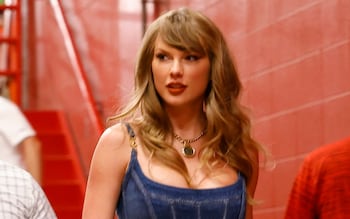
It’s important to keep on top of what we have and find ways to re-use it, because in this standardised world that’s the way to look unique. However, humble the jewel may be – its rarity is what gives it value. Be prepared this season for a nostalgic crystal chandelier trend inspired by the glamour of the “supers”, prompted by the new Disney+ documentary In Vogue: The 90s. I have a vintage pair from Butler & Wilson where everyone used to shop for glitter quotient, and I mean everyone – I spotted Princess Diana with her bodyguard picking out pieces which we called “diamante” back then.
Although I always say jewellery differs from fashion because it isn’t seasonal, I actually do have pieces that I’m putting away now that summer has ended. My gilt coral-design earrings which I wear, with a shard of rock crystal on the other side, from Goosens don’t look right during the winter months. Similarly, my 19th-century coral drops will also rest now until summer returns and I take them back to the sea.
I always love seeing people wearing charms or motifs because largely it’s short cut to knowing what means something to them. I hope in my book If Jewels Could Talk that I’ve debunked the myth that jewellery is frivolous, expensive, or that its significance lies in proclaiming status. Although a favourite pastime of mine is trying on magnificent antique jewels at SJ Phillips and imagining the lives of the women who owned them in the distant past.
Throughout history people have worn jewellery in some form, however modest, because we’re human. It’s how we choose to present ourselves – how we live and how we love, to the world.
Carol Woolton’s seven hacks to make your jewellery rock:
If Jewels Could Talk (£18.99 Simon & Schuster) available in hardcover, ebook and audiobook formats.
Disclaimer: The copyright of this article belongs to the original author. Reposting this article is solely for the purpose of information dissemination and does not constitute any investment advice. If there is any infringement, please contact us immediately. We will make corrections or deletions as necessary. Thank you.

